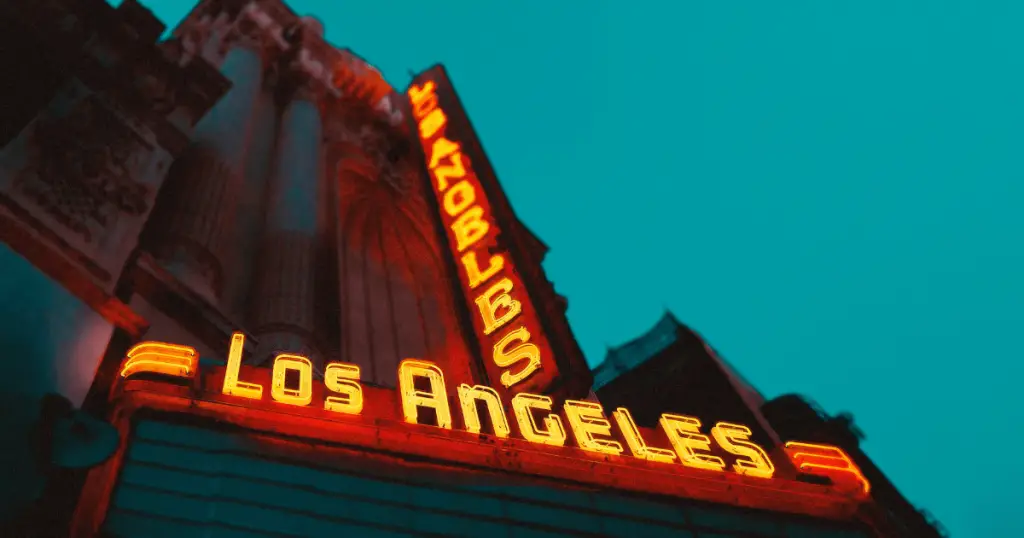The Story Behind The Flag of Los Angeles
Flags are symbols that represent a place or a community’s unique identity. One of the most iconic flags in the United States is the flag of Los Angeles. With its striking bright colors and historical significance, the flag of Los Angeles has become beloved and recognized worldwide.

Los Angeles Flag History
The current flag of Los Angeles dates back to the early 20th century when it first appeared in film production. The original design featured a large blue field with four white stars. While this is still the official design, minor adjustments have been made to reflect cultural and historical changes in the city over time.
Early Flags Used in Los Angeles
Before the adoption of the current flag, Los Angeles saw the use of several other symbols. The Spanish, Mexican, and American flags have all flown over the city, reflecting its rich history and the various cultures that have influenced its development.
The Official Adoption of The Los Angeles Flag
The official flag of Los Angeles was adopted in 1931. Roy E. Silent and E.S. Jones designed it in response to a competition sponsored by the city’s municipal flag committee. The flag’s design was intended to reflect the city’s history and its cultural and economic ties.
Critical Moments in the Flag’s History
The flag of Los Angeles has witnessed many pivotal moments in the city’s history. One notable event was in 1984, when the flag flew prominently during the Summer Olympic Games hosted by Los Angeles, enhancing its prominence and recognition. In recent years, the flag has been used in various city-wide celebrations and movements, cementing its place as an enduring symbol of Los Angeles’ identity.
Design Elements of the Los Angeles Flag
The current design of the Los Angeles flag features a white background and four red stars. The stars symbolize the original four Spanish colonial settlements in the area, while the blue field represents the Pacific Ocean and its surrounding canyons, mountains, and valleys.
Description of the Flag’s Colors and Layout
The flag of Los Angeles is strikingly colorful, consisting of a vibrant tricolor background of green, gold, and red, laid out horizontally. Each color occupies one-third of the flag’s expanse, with green at the top, gold in the middle, and red at the bottom.

How the Flag Represents the City’s Diversity and Heritage
The flag’s design and color scheme have been carefully chosen to encapsulate Los Angeles’ diverse cultural history and rich heritage. The olive trees represented by the green color speak to the city’s agricultural past.
The gold is a nod to the warm, sunny climate Los Angeles is known for, while the red honors the city’s Native American origins. The three stars are a constant reminder of the city’s journey through different eras of governance. Thus, the flag is not just a piece of fabric but a visual representation of Los Angeles’ intricate tapestry of cultures and history.
The Three Red Stars of the Los Angeles Flag
The three red stars adorning the flag of Los Angeles are not just decorative elements but symbols steeped in the city’s rich history and culture.
The Significance of the Stars in the Flag
Each star on the flag carries a profound significance, representing the three nations that have ruled over Los Angeles throughout its history: Spain, Mexico, and the United States.
These stars serve as a reminder of the city’s evolution through different periods of governance, each leaving its unique imprint on the city’s culture, architecture, and societal norms.
Historical Context Behind the Stars
The first three stars represent Spain, acknowledging the Spanish colonizers who founded the city in the late 18th century. The second star signifies Mexico, under whose control Los Angeles came after Mexico’s independence from Spain in 1821.
The third star symbolizes the United States, which took over Los Angeles following the Mexican-American War of 1848. Each star, therefore, encapsulates a specific era in Los Angeles’ history and the influences it brought.
Interpretations of the Stars’ Meanings
The stars’ colors have also been interpreted symbolically. The red color of the stars is seen as a representation of courage, vigor, and resilience – attributes that have characterized Los Angeles and its people across these three periods of rule. Furthermore, the stars’ positioning in the center of the flag also suggests the city’s central role in these three nations’ historical and cultural narratives.

The Green Fields of the Los Angeles Flag
The vibrant green color that adorns the top band of the Los Angeles flag is more than mere aesthetics; it serves as a powerful symbol representing the city’s natural landscapes, climate, and commitment to the environment.
Representation of Nature in the Flag
The green color in the flag symbolizes the olive trees, a significant part of Los Angeles’ natural landscape and agricultural history. In addition to olives, the green also represents the lush vegetation and verdant landscapes surrounding the city, including the scenic parks, gardens, and forests that are integral to Los Angeles’ natural beauty.
Link to Los Angeles’ Mediterranean Climate
Los Angeles is known for its Mediterranean climate, characterized by mild, wet winters and warm, dry summers. The green color in the flag is a nod to this characteristic climate, representing the lush vegetation supported by the winter rains and sustained through the long, sun-soaked summer months.
Environmental Awareness and Its Connection to the Flag’s Green Color
In a broader context, the green color in the Los Angeles flag symbolizes the city’s commitment to environmental awareness and sustainability. It is a constant reminder of the need to preserve the city’s natural landscapes and promotes a culture of environmental stewardship. This flag element aligns with Los Angeles’ ongoing efforts to reduce its carbon footprint and work towards a more sustainable future.
The Native American Pueblo in the Los Angeles Flag
The Native American Pueblo is present in spirit within the flag, represented by the vibrant red band, and its influence plays a crucial role in defining Los Angeles’ cultural and historical identity.
The Pueblo as a Central Element of the Flag
Though not physically depicted, the influence of the Pueblo is crucially felt in the flag’s design. The red band at the bottom of the flag is a homage to the courage and perseverance of the city’s Native American origins. This color symbolism is a constant reminder of Pueblo’s significant role in shaping the city’s past and present.

Historical Importance of Native American Culture in Los Angeles
The Pueblo were the city’s original inhabitants, and their rich culture and traditions formed the bedrock of Los Angeles’ diverse heritage. They introduced agriculture, arts, and spirituality that continue influencing the city’s cultural landscape. The red band on the flag is a tribute to their contribution and a testament to the city’s historical roots in Native American culture.
Efforts to Acknowledge and Celebrate Native American Heritage
Los Angeles has consistently made concerted efforts to acknowledge and celebrate its Native American heritage. This is represented through the flag and in numerous cultural festivals, historic preservation projects, and educational programs aimed at keeping the Pueblo history and culture alive.
The city’s commitment to honoring its Native American roots is a testament to the enduring influence of the Pueblo, ensuring their story remains an integral part of Los Angeles’ identity.
Conclusion: Flag of Los Angeles
The flag of Los Angeles serves as a vibrant tapestry, interweaving significant elements of the city’s history, culture, and natural environment. The three red stars symbolize the three nations that have ruled Los Angeles, each contributing unique influences to the city’s evolution.
The green band represents the lush natural landscapes and acknowledges the city’s commitment to environmental sustainability.
The red band, evocative of Pueblo’s impact, pays homage to the city’s original inhabitants and their enduring cultural legacy. Through these symbols, the flag effectively encapsulates the rich tapestry of Los Angeles’ past, present, and future, and stands as a testament to its diverse heritage and continual growth.







